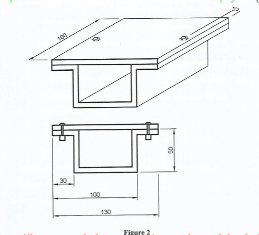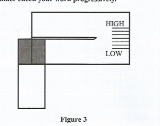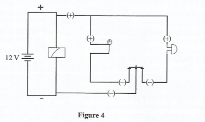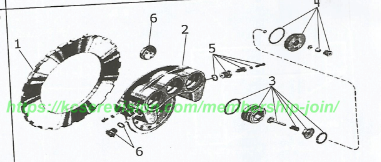QUESTIONS
INSTRUCTIONS
STATION I
Figure 1 shows an assembly drawing of a light aircraft system part.
- Identify the system and name the parts labelled 1, 2 and 3. (2 marks)

- On the drawing paper provided, sketch in good proportion the exploded view of the unit labelled 3.(8 marks)
STATION 2
INSTRUCTIONS
Using the tools, equipment and materials provided, make the aircraft longeron as shown in Figure 2. ( 10 marks)
STATION 3
INSTRUCTIONS
- Study the aircraft components marked A, B, C, D, E and F and then perform the tasks detailed
in Table 1.(6 marks)
PART IDENTIFICATION FUNCTION A B C D E - Using the tools and equipment provided, perform each of the following tasks.
- Set the outlet compressor pressure at 15 psi and release the press right angle appropriately to blades on set up G (1 mark)
Let the examiner check your work. - Record your observations. (1 mark)
- Relate your observations to an aero gas turbine engine. (1 mark)
- Dismantle the set-up. (1 mark)
Let the examiner check your work.
- Set the outlet compressor pressure at 15 psi and release the press right angle appropriately to blades on set up G (1 mark)
STATION 4
INSTRUCTIONS
- Using tools and materials provided, make a simple model of the weather instruments shown in Figure 3. (4 marks)
Let the examiner check your work progressively.
-
- Light the bumer and place it under the can for about 40 seconds.
Record your observation.
Observation (1 mark)
State the reason behind the observation in (b)(1). (1 mark)
Reason - Gently press down on the balloon.
Record your observation.
Observation
State the reason behind the observation in (b)(ii).
Reason
- Light the bumer and place it under the can for about 40 seconds.
- Identify the instrument and its application in the aviation industry.
Instrument (1⁄2 mark)
Application (1⁄2 mark) - From your observation in (b)(i) and (b)(ii) state the relationship to the atmospheric conditions and the effects of these changes.
- Relationship (1⁄2 mark)
- Effects (1⁄2 mark)
INSTRUCTIONS
STATION 5
- Identify each of the aircraft parts, materials and systems labelled 1-8 and complete
Table II and II
LABEL PART MATERIAL 1 2 3 4
Table II (4 marks)
LABEL PART SYSTEM 5 6 7 8
Table III (4 marks) - Apply the given loads on each of the materials labelled 9-10 and complete Table IV.
MATERIAL LOAD OBSERVATION PROPERTY 9 Tension 10 Bending
Table IV (2 marks)
STATION 6
INSTRUCTIONS
- Study and identify each of the signs marked G, H, I, J, K, and L.. (3 marks)
SIGN IDENTIFICATION G H I J K L - Using the aeroplane model provided, demonstrate to the examiner each of the following (4 marks)
- Yawing
- Overshoot
- Rolling
- Pitching
- Demonstrate to the examiner each of the following helicopter marshalling signals (3 marks)
- Move horizontally right
- Move downwards
- Hover
INSTRUCTIONS
STATION 7
Using the parts marked O, P and Q perform each of the following tasks
-
- Connect Pipe X to port P on the instrument marked "O".
Let the examiner check your work. (1 mark) - Apply a pressure of 5 pei to port marked "P' and record your observation. (1 mark)
Observation - Connect Pipe Y to port Q (1 mark)
Let the examiner check your work. - Apply pressure of 5 psi and recced your observation. (1 mark)
Observation - Rele pressure on P and record your observation (1 mark)
- Connect Pipe X to port P on the instrument marked "O".
- Explain the rs behind the observation in (x)(i) and (a)(iv) with reference to an
all in level flight. (2 marks)
Reason a (ii)
Reason(a)(iv) - Study the instrument marked XY and identity range markings coloured RED, YELLOW and GREEN (3 marks)
- RED
- YELLOW
- GREEN
STATION 8
INSTRUCTIONS
-
- Connect the components provided as shown in the circuit in Figure 4. (5 marks)
Let the examiner check your work
- Pre the switch to "ON" position and record your observation. (1 mark)
- State where the system is applicable on an aircraft. (1 mark)
Application - Give two reasons for use of the system no an aircraft. (1 mark)
Reasons
- Connect the components provided as shown in the circuit in Figure 4. (5 marks)
- State the function of each component in the circuit in Figure 4. (2 marks)
STATION 9
- Using the most appropriate tools, take and record the measurements of the aircraft components painted red, white, green and blue and complete Table (V).
AREA TO BE MEASURED MEASUREMENT TAKEN TOOLS USED Outside diameter for part painted RED The angle of the part painted WHITE The gap of part painted GREEN Internal diameter of part painted BLUE
Table (V) (6 marks) - Identify the aircraft hardware labelled T, U, V and W and state one probable defect for each and complete Table (VI).
HARDWARE DIRECT T U V W
Table VI (4 marks)
STATION 10
- Study the specimens labelled 11-14 and for each:
- identify the specimen
- state the use.
- state the system applicable.
Complete Table (VII). (6 marks)
SPECIMEN IDENTITY USE SYSTEM 11 12 13 14
-
- Disassemble the component marked 15. (1⁄2 mark)
Let the examiner check your work. - Identify the parts painted red, blue, white and green. (2 marks)
Red
Blue
White
Green - Carry out the servicing. ( 1 mark)
- Assemble the component (1⁄2 mark)
Let the examiner check your work.
- Disassemble the component marked 15. (1⁄2 mark)
MARKING SCHEME
- System: Landing gear
Parts- Brake disc
- Strut
- Brake housing
(4x-2 mark)

(2 marks)
Proportionality 1x1-1 mark
Correct arrangement of parts 1x1-1 mark
Sketching the parts correctly 1-6
6x1-6 mark
(Any from each group) 8 marks
STATION 3
| PART | IDENTIFICATION | FUNCTION |
| A | Exhaust valve | it opens to permit the expulsion of exhaust gasses from the combustion after ignition has occured. |
| B | Turbine Blade | To extract energy from the high temperature, high pressure gas produced by the combustor. |
| C | Ball Bearing | Carries loads, reduces friction and positions moving parts. |
| D | propellor | It is set at a pitch to form a helical spiral to transform rotational power into linear thrust by acting upon the air. |
| E | Camshaft | Converts circular or rotational motion into reciprocating or oscillatory motion. to operate the intake and exhaust valves in the reciprocating engines. |
| F | Magneto Distributor Block | To distribute the ignition surges to the individual spark plugs in the correct sequence. |
| 12 × 1⁄2 = 6 marks | ||
| (b) | ii observation | |
| ii relationship |
STATION 4
-
- Obsevation
Reason - Observation
Reason
- Obsevation
- instrument: Barometer
Application: Measuring the changes in atmospheric pressure. -
- changes in atmospheric pressure
- Cause wind/air movement
STATION 5
| (a) | PART | MATERIAL |
| 1 | Gear | Stell alloy/ Aluminium |
| 2 | Electrical cable | Copper |
| 3 | Aircraft control surface cable | Galvanized steel |
| 4 | Rigid Hydraulic system pipe | Aluminium alloy |
| (b) | PART | SYSTEM |
| 5 | Flexible aircraft fuel pipe | Fuel system |
| 6 | Turbine blade | Gas turbine engine |
| 7 | Pulley | Flight control system |
| 8 | Exhaust Valve | piston engine |
| (c) | MATERIAL | LOAD | OBSERVATION | PROPERTY |
| 9 | Flexible rubber | Tension | Returns to original shape and size | Elasticity |
| 10 | Aluminium strip | Bending | Easily bends and retains new shape |
Malleability Plasticity |
STATION 6
| G | Flammable material/Elavator |
| H | Strong magnetic field/Fla |
| I | Obstacle/Aerolon |
| J | General danger/ Fuselage |
| K | Oxidant material/wing |
| L | Electrical hazard/ Engine |
STATION 7
-
- Dial moves, indicating increase
- No change in dial reading
- Dial moves in the opposite direction(decreasing)
-
- In level flight, the static pressure is held constant
- Dynamic pressure increased with increase in forward speed.
-
- Green-normal operating range
- Yellow-caution range
- Red-Never exceeding range
STATION 8
-
-
- The lamp lights up
- The buzzer rings
- Makes relays
- Landing gear extension/retraction system.
-
- Warning/Fire protection
- Alerting/External lighting in Aircraf
-
- Battery Provide power
Relay Switching mechanism
Lamp Indication (lighting)
Buzzer-Warning/ alerting/audio
Switch Circuit connection
STATION 9
-
AREA TO BE MEASURED MEASURMENT TOOL USED Red - outiside diameter SAMPLE DATA Vernier caliper White - angle SAMPLE DATA Bevel gauge green - gap SAMPLE DATA Feeler gauge Blue - internal diameter SAMPLE DATA Ball and macro meter -
HARDWARE DEFECT T- control cable corrosion
broken wiresU-circlip cracks or distortion
loss of springgingnessV- tab washer broken tab
cracksW- tapered roller bearing signs of overheating
corrosion
crcks
STATION 10
-
SPECIMEN IDENTIFICATION PURPOSE SYSTEM 11 grease reduce friction lubrication landing gear
flight control12 hydraulic flui transfer of power landing gear
flight control
breaking system13 kerosene chemical power jet engine propulsion
system14 turubuckle joining cables engine and flight
controls -
-
- Driven gear
- Driver
- Inlet port/Housing
- Housing/Hexagonal head bolt
(4 x 0.5-2 marks)
-
Download Aviation Technology Paper 2 Questions and Answers - KCSE 2022 Past Papers.
Tap Here to Download for 50/-
Get on WhatsApp for 50/-
Why download?
- ✔ To read offline at any time.
- ✔ To Print at your convenience
- ✔ Share Easily with Friends / Students
